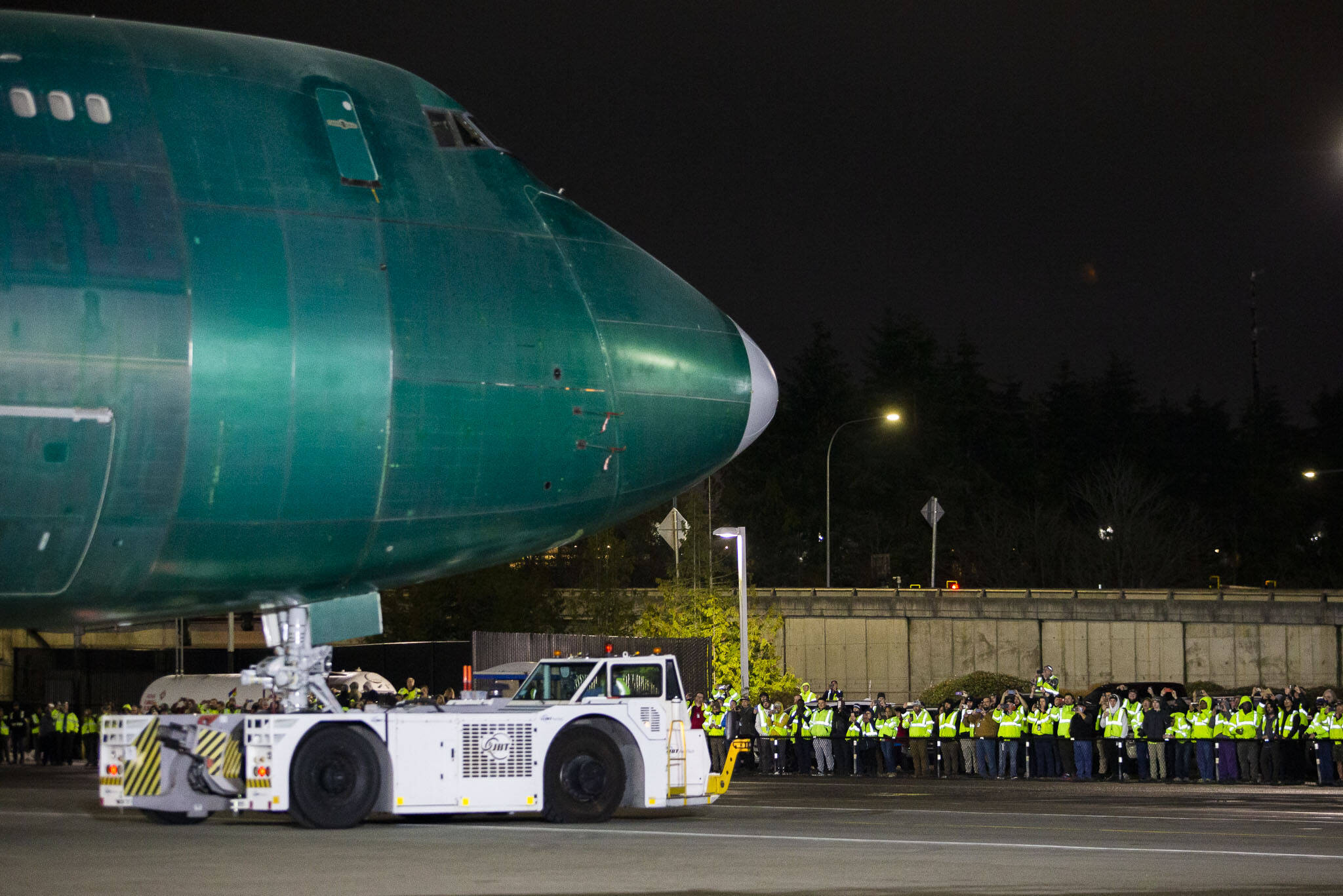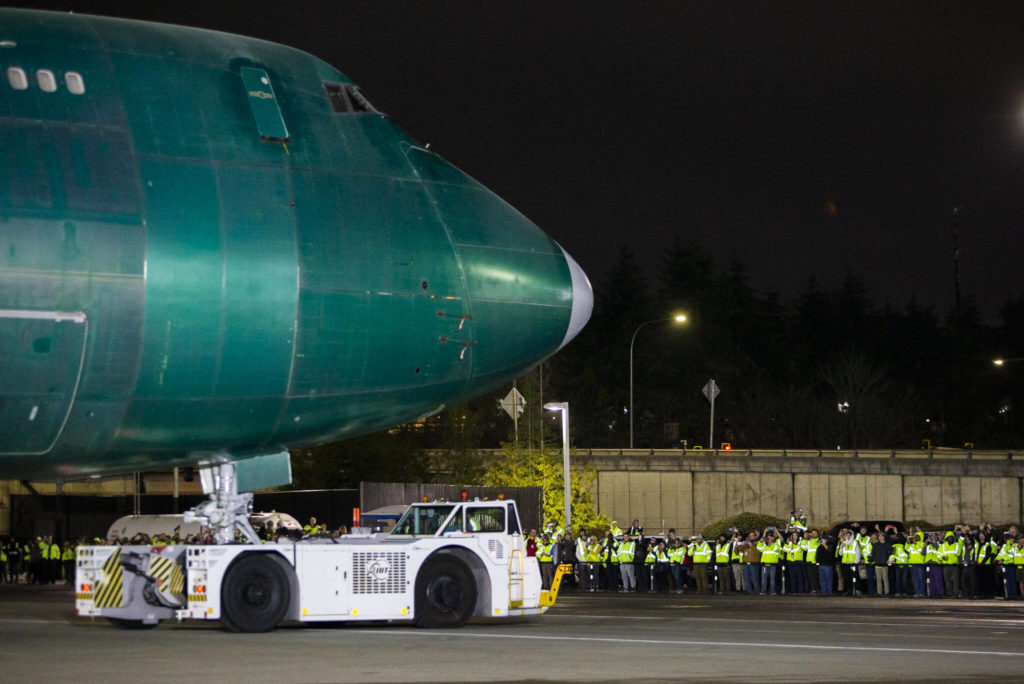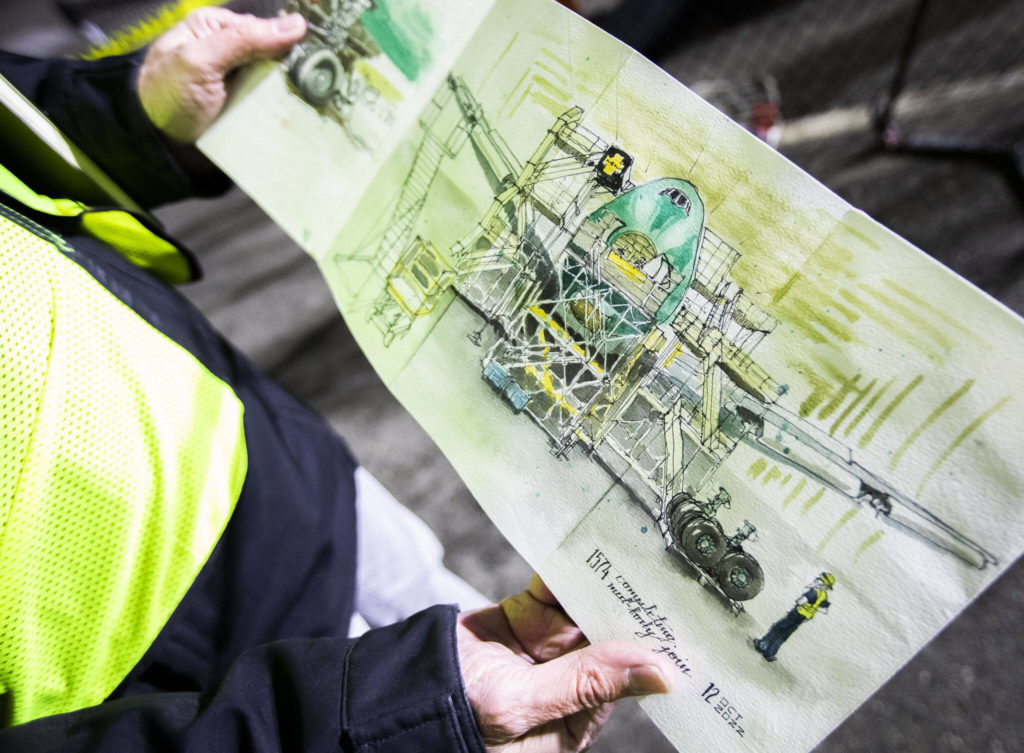EVERETT — The Queen of the Skies has left the building.
On Tuesday night, the last Boeing 747 rolled out of The Boeing Co.’s assembly factory at Paine Field.
Hundreds of workers gathered inside and outside the Everett plant to bid the wide-body plane — tail number N863GT — goodbye.
Many wore bright yellow safety vests that said, “The Last 747, Queen of the Skies,” the airplane’s nickname.
A white tow truck slowly pulled the 747-8 freighter, still wrapped in a green plastic protective layer, toward the Boeing flight line at Paine Field.
In full view of the crowd, the tow truck stopped briefly, a cue for the 747 to be revered and admired. And so they did, with cheers and whistles and a few solemn tears.
Like the first 747 that rolled out of the Everett factory in 1969, the latest model has four engines, is as tall as a six-story building and retains the distinctive hump that houses the cockpit.
In the coming weeks, the last 747 will be painted and prepped for delivery to Atlas Air early next year.
For Dave Bruton, who began his Boeing career in 1988 with the launch of the 747-400 variant, it was the end of an era.
“In my 34 years here, I’ve been all over the 747,” Bruton said. In his job as a control specialist, he adjusted the plane’s flight controls and participated in engine tests. “I got to sit in the co-pilot’s seat for engine runs,” he said.
“It’s a shame it had to come to an end,” Bruton said after the plane passed by.
In an email Tuesday, a Boeing spokeswoman told The Daily Herald: “There are no employment reductions expected as a result of 747 production closeout. Employees will move on to support other airplane programs.”
Kathleen Wandler, a Mill Creek resident, who has worked for Boeing since April, described the mood among workers Tuesday as “bittersweet.”
“We have people who have worked on the 747 for their entire career. Now they’re anxious about going to another program or retiring. This is not something they thought would not happen,” Wandler said of the program’s end. Wandler said she works on the 767 line but is “associated” with the 747. “We’re excited to have them join us on the 767.”
Kim Smith, Boeing’s vice president and general manager of the 747 and 767 programs, watched the final rollout Tuesday night.
“It’s very emotional,” Smith said. “I think the original Incredibles (the team that built the first 747) would be very proud.”
No. 1,574
During 55 years of production — from 1967 until now — Boeing built 1,574 of the wide-body aircraft.
Multiple variants were developed, including the Dreamlifter, big enough to deliver Boeing aerospace parts. And a pair of 747s, known as the VC-25A, were modified to carry the President of the United States. The two planes entered service in the 1990s under the call sign Air Force One. Now, two 747-8s are being kitted out in Texas to replace them, said Mike Lombardi, Boeing’s official historian, on Tuesday night.
In the late 1980s, Boeing produced about one 747 a week. In recent years, the pace of production slowed to about six airplanes a year.
Demand for the big jet lessened. The remaining orders were for 747 freighters configured to haul cargo. Shipping containers and cargo are loaded through the plane’s huge hinged nose.
The last 747 in passenger service with a U.S. airline was retired and put out to pasture in 2018.
In 2016, Boeing said it could discontinue producing the iconic aircraft but didn’t offer details. In 2020, the company announced the 747 program would shutter in 2022.
It’s another wide-body plane that’s left the building.
The company stopped building the Boeing 787 at the Everett plant when it consolidated the plane’s production to the company’s South Carolina assembly plant in spring 2021.
Until then production had been split between the Everett campus and the South Carolina plant. The last 787 Dreamliner rolled out of the Everett plant in February 2021.
“Currently the 777 and 767 families (including the KC-46) are assembled and delivered at Everett,” a Boeing spokesperson wrote in an email. “The new 777X family, including the 777-9, 777-8 and 777-8 Freighter, will also be assembled and delivered in Everett. The Everett site also supports deliveries of the 737 MAX and 787 Dreamliners, meaning the site supports the entire commercial product line.”
Boeing has been marketing the newer and more fuel efficient 777-8 freighter as its replacement for the 747 freighter.
‘Boeing is investing’
Now the question is, “What will the space left by the 747’s departure be used for?”
The assembly line occupies one bay of the massive Everett plant.
“Boeing is investing in the Everett site and the Everett team as we continue to create a long-term future for the aerospace industry in Washington state,” a Boeing spokeswoman said.
A Boeing employee, who declined to be named because they were not authorized to speak on behalf of the company, said Tuesday the 747 bay “was already being gutted.”
“I’ve seen them taking out the pieces,” the worker said. “I’ve heard rumors that when the lease on the Renton building is up, they’ll bring the 737 up here,” the worker added. The Boeing 737 series is produced in Renton.
Until late this year, aviation analysts speculated that the 747 or the 787 bay might be used for production of a new Boeing passenger plane, informally referred to as the 797 or NMA, the new mid-market airplane.
But hopes for a new Boeing passenger aircraft anytime soon were dashed earlier this year, when Boeing’s CEO David Calhoun said the company would not introduce a new airplane until the mid-2030s. Richard Aboulafia, a well known industry analyst with AeroDynamic Advisory, a Michigan consulting firm, called the announcement a “game changer” that could threaten Boeing’s commercial airplane business.
“The announcement was a significant departure from Calhoun’s comments (in June 2021) that it would be a ‘couple of years’ before a new jetliner was launched. The new time frame means that over 25 years will have lapsed between Boeing all-new jetliner launches, assuming that the new jet will be launched in 2030,” Aboulafia told Forbes last month.
Boeing has not designed a new, clean-sheet airplane since 2003, when it began developing the 787.
‘City of Everett’
Everett was one of dozens of locations the airplane manufacturer considered when it proposed building an assembly plant for the 747 in the mid-1960s. Sites in California and Moses Lake, Washington were considered.
In 1966, Boeing chose Everett’s Paine Field, where the airplane manufacturer has had a presence since the early 1940’s. Construction of the factory, specially built to house the world’s first twin-aisle jet, began that same year in June. Twelve months later, the doors opened, welcoming thousands of Boeing workers.
Today, the sprawling plant is the largest manufacturing building in the world by volume, covering nearly 100 acres. Approximately 30,000 employees work at the plant in three shifts, the company said.
The late Joe Sutter, the program’s chief engineer, led a team of 4,500 engineers who developed the 747. The jetliner was expected to carry more than 350 passengers between continents, making it about 2½ times bigger than the largest airliners of the day: the 707 and the Douglas DC-8.
Engineers and machinists worked with slide rules and hand drawings to design the plane. More than 75,000 drawings were completed detailing the assembly of its 4.5 million parts, according to a 2016 report in The Herald.
Work on the plane began in 1967. The entire team was known as the “Incredibles.”
Boeing risked a huge portion of its net worth on the 747 program, and a miss could have spelled bankruptcy, according to aviation historians.
On a cold cloudy day, Feb. 9, 1969, a Boeing 747, the world’s first twin-aisle airplane made its debut, when it rolled out of The Boeing Co.’s new Everett assembly plant for the first time.
A crowd had gathered at Paine Field to gape at the jumbo jet and to cross their fingers for its first test flight.
The prototype was dubbed the “City of Everett.”
The sun broke through the clouds, and the jumbo jet took to the air for 85 minutes. Afterward, the two test pilots waxed lyrical over how easily the big bird handled.
In December 1969, less than 11 months after its first test flight, the 747 was certified for commercial flight by the Federal Aviation Administration.
On Jan. 21, 1970, the plane entered service under the Pan Am livery.
Boeing had made good on its promise to meet Pan Am’s 28-month delivery deadline. Today, the aerospace company might spend several years designing and building a new aircraft model.
That first model, with call letters RA001, can be viewed today at The Museum of Flight at Boeing Field in Seattle.
The 747 revolutionized and expanded air travel. It allowed more people to fly farther, faster and more affordably than ever before, Boeing said.
“For more than half a century, tens of thousands of dedicated Boeing employees have designed and built this magnificent airplane that has truly changed the world,” said Smith, vice president and general manager of 747 and 767 programs. “We are proud that this plane will continue to fly across the globe for years to come.”
Janice Podsada: 425-339-3097; jpodsada@heraldnet.com;
Talk to us
> Give us your news tips.
> Send us a letter to the editor.
> More Herald contact information.





























